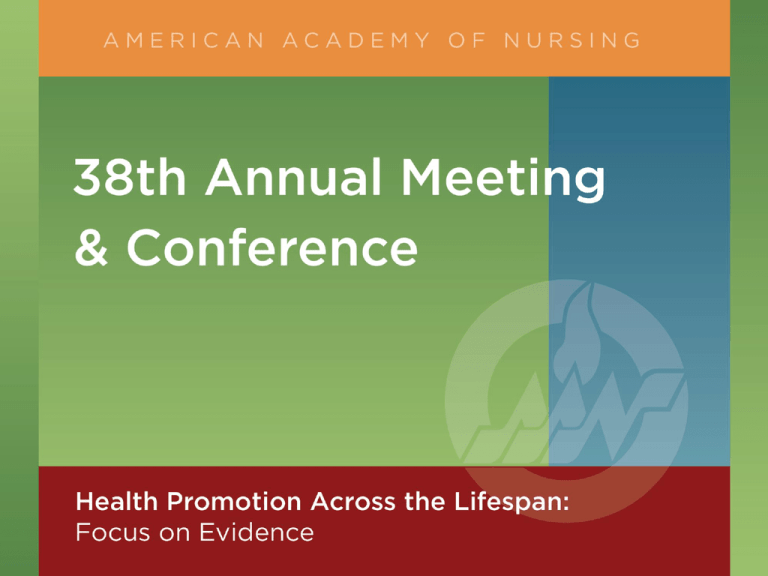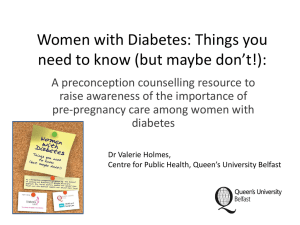
+
Health Promotion for
Women: State of the
Science
Nancy Fugate Woods, PhD, RN, FAAN
Biobehavioral Nursing and Health Systems, School of Nursing
University of Washington
+
Co-authors: Women’s Health Expert
Panel Writing Group
Judy Berg, University of Arizona
Ellen Olshansky, University of California, Irvine
Joan Shaver, University of Arizona
Diana Taylor, University of California, San Francisco
+
Aims
Assess progress in the science of health promotion, including
prevention, for girls and women
Propose evidence-based innovations relevant to meeting
needs of diverse populations of girls and women
Recommend an agenda for expanding research and
innovation in health promotion for girls and women
Suggest strategies to influence policy agendas at the local,
regional, and national level assuring nursing’s contributions
to health promotion remain a critical element of health care
reform
+
Convergence of Women’s Health
Influence: 2010-2011
Federal government interest in women’s health noteworthy in
2010-2011
Renews agendas for women’s health research
Evaluates the impact of women’s health research
Uses evidence from women’s health research to set policy
(Affordable Care Act)
Creates a strategy for health promotion and prevention in the
nation
Extends consideration of women’s health globally
The first NIH
Women’s Health
Research Agenda
was developed in
1991 under the
leadership of Ruth
Kirschstein,
Acting Director of
the Office of
Research on
Women’s Health
with support of
NIH Director
Bernadine Healey
+
Resurgence of Federal Commitment to
Women’s Health Research
Office of Research on Women’s Health, NIH. (2010) Moving
into the Future with New Dimensions and Strategies: A Vision
for 2020 for Women’s Health. ORWH, NIH.
Institute of Medicine (2010) Women’s Health Research:
Progress, Pitfalls, and Promise. Washington, CD, The National
Academies Press.
+
Moving into the Future with New
Dimensions and Strategies: A Vision for
2020 for Women’s Health (2010)
+
ORWH Goals for 2020
Goal #1: Increase sex differences research in basic science
studies, especially at cellular and tissue levels
Goal #2: Incorporate findings of sex/gender differences in the
design and applications of new technologies, medical devices, and
therapeutic drugs
Goal #3: Actualize personalized prevention, diagnostics, and
therapeutics for girls and women
+
ORWH Goals 2020
Goal #4: Create strategic alliances and partnerships to
maximize the domestic and global impact of women’s health
research
Goal #5: Develop and implement new communication and
social networking technologies to increase understanding of
women’s health and wellness research
Goal #6: Employ innovative strategies to build a welltrained, diverse, and vigorous women’s health research
workforce
+
Women’s Health Research: Progress,
Pitfalls, and Promise (IOM, 2010)
+
Are women’s health researchers:
Addressing the most appropriate and relevant determinants of
health?
Focusing on most appropriate and relevant health conditions?
Engaging with (studying) the most relevant groups of women?
Utilizing the most appropriate research methods?
Translating findings to affect practice?
Conveying findings effectively for women?
+
Assessment of Progress
MAJOR PROGRESS
SOME PROGRESS
Breast cancer
Depression
Cervical cancer
Osteoporosis
Cardiovascular disease
HIV/AIDS
+
Conditions with Little Progress
Unintended pregnancy
Maternal morbidity/mortality
Autoimmune diseases
Alcohol and drug addiction
Lung cancer
Gynecological cancers other than cervical cancer
Nonmalignant gynecological disorders
Alzheimer’s Disease (IOM 2010)
+
Recommendations from IOM Study on
Women’s Health Research (2010)
Recommendation 1: US government agencies and other
relevant organizations to sustain/strengthen focus on
women’s health, including genetic, behavioral, and social
determinants of health and change over lifetimes.
Recommendation 2: The National Institutes of Health, the
Agency for Healthcare Research and Quality, and the Centers
for Disease Control and Prevention - develop targeted
initiatives to increase research on populations of women
with highest risks and burdens of disease
+
IOM Study 2010
Recommendation 3: Research should emphasize
promotion of wellness and quality of life; conditions that
affect quality of life; better measures or metrics of quality of
life to be used as outcomes
Recommendation 4: NIH Cross-institute initiatives on
common determinants and risk factors that underlie
multiple diseases, interventions to decrease the occurrence
or progression of diseases in women
+
IOM Study 2010
Recommendation 5: Government … funding agencies
ensure adequate research participation by women,
analysis of data by sex, and reporting of sex-stratified
analyses.
Recommendation 6: Research emphasis on how to
translate research findings into clinical practice and
public-health policies rapidly – to practitioner and overall
public-health systems levels.
+
IOM Study 2010
Recommendation 7: The Department of Health and Human
Services - appoint a task force to develop evidence-based
strategies to communicate and market to women health
messages based on research results
+
Shaping Policy Supporting Women’s
Health Services
+
Commitment to Women’s Health
Services and Policy
Affordable Care Act – includes provisions for services for
women, prohibits gender-based discrimination in denying
coverage, assuring maternity care coverage as an essential
benefit and increased coverage for the poor
Institute of Medicine (2011) Clinical Preventive Services for
Women: Closing the Gaps. Washington, DC: The National
Academies Press
National Prevention Council. (2011). National prevention
strategy: America's plan for better health and wellness.
Washington, DC: U.S. Department of Health and Human Services,
Office of the Surgeon General
+
IOM Committee on Clinical Preventive
Services
Recommended inclusion of USPSTF A and B Recommended
Services to be included in Clinical Preventive Services with
Affordable Care Act
Also suggested providing additional clinical preventive
services as part of ACA, including clarification of those
services with incomplete evidence (C or I classification) to
be included in well woman services
+ IOM Clinical Preventive Services :
Suggested Well Woman Services
Diet and Physical Activity
Establishing pregnancy history of CVD-related conditions
Mental Health
Metabolic syndrome
Preconception Care
Prenatal Care
STIs
+
IOM Recommendations: Additional
Clinical Preventive Services
1.
Screening for gestational diabetes
2.
Human papillomavirus testing
3.
Counseling for sexually transmitted infection
4.
Counseling and screening for human immunodeficiency
virus
5.
Contraceptive methods and counseling
6.
Breastfeeding support, supplies, and counseling
+
IOM Recommendations: Additional
Clinical Preventive Services
7.
Screening and counseling for interpersonal and domestic
violence
8.
Well woman visits (one annually) - several visits may be
needed to obtain all necessary recommended preventive
services (includes 29 USPSTF A and B rated services +
others recommended by the committee)
+
National Prevention and Health
Promotion Strategy: America’s Plan
for Better Health and Wellness
Surgeon
General released first national
Prevention Strategy Jun3 16, 2011
Four
Strategic Directions
Seven
Areas of Focus
+
Four Strategic Directions
Building
Healthy and Safe Community
Environments
Expanding
Quality Preventive Services in
Both Clinical and Community Settings
Empowering
People to Make Healthy
Choices
Eliminating
Health Disparities
+
Seven Areas of Focus
Tobacco
Free Living
Preventing
Healthy
Drug Abuse and Excessive Alcohol Use
Eating
Active
Living
Injury
and Violence Free Living
Reproductive
Mental
and Sexual Health
and Emotional Well-being
+
Global Commitment to Women’s Health
World
Health Organization’s strategic
plan for 2010-2015 Sexual and
Reproductive Health
U. S. State
Department (2010)
Implementation of the Global Health
Initiative
International Congress on Women’s
Health Issues (ICOHWI)
ORWH Research
Agenda (2010)
STATE OF THE SCIENCE TO PREVENTIVE
SERVICES
State of the
Science on
Health
Promotion
and
Prevention
IOM Report on
Women’s Health
Research (2010)
IOM Report on Clinical
Preventive Services
(2011)
National Prevention Council
Strategy (2011)
Health
Promotion
and
Preventive
Services:
Best
Evidence
Proposed
Commission:
Recommends
Coverage of
Preventive
Services for
Women
+
Nursing’s Commitment to Health
Promotion
Nursing’s
early commitment to health
promotion and health promoting lifestyle
patterns traceable to NCNR Priority Expert
Panels (1980s) to set priorities for funding
Exemplified
by Pender and colleagues’
work on health promotion and health
protection or prevention
+
National Institute for Nursing Research
Strategic Plan for Health Promotion
“Health promotion and
disease prevention form
the keystone of our
science, reflecting current
understanding of the
most effective
approaches to
maintaining health” NINR
Strategic Areas of
Research Emphasis 2006
+
Changing Science of Health Promotion
FROM (1980s)
TO PRESENT
Individuals as the unit of
health promotion: an
individual responsibility
Social groups, e.g.
organizations, communities,
larger society responsible
Gender-ignorant models of
health promotion
Gender-sensitive, genderspecific models
Health promotion for
predominantly healthy people
Health promotion in chronic
illness, acute illness,
integration with symptom
management
+
Changing Science of Health Promotion
FROM
TO
Emphasis on individual
activities, raising awareness
Raising social consciousness
and inviting social action
Individual and group
coaching, counseling
Multiple interventions at
multiple levels to initiate and
sustain behavior changes
Environmental interventions,
e.g. built environment
+
Changing Science of Health Promotion
FROM
Local and country-specific
models
Limited scalability
Awareness ofTO
globalization,
Appreciation of urbanization,
industrialization and
associated inequities
Local
Increased use of
communication and
information technologies to
enhance scalability
global
+
Recommendations from Nursing
Researchers on Health Promotion
1.
Expand development and testing of
gender-sensitive interventions for women
Gender
as a major feature vs human
experience as universal
Women’s
own voices and experiences,
women’s own perspectives (Im and Meleis
2001)
+
2. Consider Intersectionality as a basis
for understanding gender disparities,
health disparities of women
Gender
Race
Class
Ethnicity
Sexual
Orientation
Abledness
+
Nature
of women’s experiences incorporate
complexities and diversities (gender,
sexuality, ethnicity, race, social class)
Intersectionality
not just a mediating factor
in a model (Im and Meleis 2002)
+ 3. Balance Emphasis on Behavioral,
Integrative and Pharmacological
Therapeutics
Evidence for health
promotion using either
behavioral or
pharmacologic approaches
vs combinations, bundled
approaches
Use of step-wise
approaches, e.g. begin with
a single, low risk strategy
and build on it
Learn from low-resources
countries
+
4. Focus on Under-emphasized
Conditions Disproportionately Affecting
Women
Functional
and stress-related disorders such as
fibromyalgia, functional gut disorders, posttraumatic stress disorder, eating disorders,
migraine headaches
Culturally
sensitive and women specific
problems, e.g., incontinence, women’s sexual
dysfunctions
+
5. Promote Research on Preventing
Unintended Pregnancies and STIs
US
rates of unintended pregnancy are high and Healthy
People Goals for 2010 unmet
Counseling
strategies for promoting healthy
reproductive and sexual behaviors across the lifespan
not adequately studied
Integration
of behavioral change counseling and
pharmaceuticals, e.g. family planning, reproductive
health planning
+ 6. Promote Research on Preventing
and Treating Consequences of
Violence against Women
Integrate
with Veteran Women’s Health Agenda
efforts, e.g. VA sponsored initiatives
Collaborate
with multi-level interventions for
violence reduction in homes, communities,
society
Look
for multiple outcomes at multiple levels,
e.g. may support reduced rates of unintended
pregnancy, sexual transmitted infections
+
Gender-Sensitive Models for Research
on Unintended Pregnancy, STIs and
Violence against Women
Awareness
of ideological imperatives and
epistemological assumptions – what we study
and what we ignore …
Sociopolitical
contexts and constraints
considered - empowerment, emancipation
Guidelines
2001)
for action > praxis (Im and Meleis
+
7. Develop and Test Technologies for
Behavioral and Functional Support
Develop
and test technological devices to enable
women to age well in place
Enhance
technologies to support caregivers
Adapt
communications technologies for research
dissemination to women
Monitoring
technologies for detection of health
problems, communication with health professionals at a
distance
+ 8. Refine/Test Models for Translating
Research Findings Directly to Women
Following publication of
WHI results in 2002
a
dramatic increase in
women’s questions for
primary care providers,
a
decrease in
prescriptions for
hormone therapy
increased
interest in
complementary and
alternative therapies …
+
Nursing Innovations for Promoting
Women’s Health: Toward 2020
Preconception
Unintended
Violence
Counseling in Primary Care
Pregnancy Prevention
Prevention
Sexually Transmitted
Smoking
Infection Prevention
Cessation
Well Woman
Depression
Care (Physical activity, Diet)
prevention
+
Preventing Unintended Pregnancy -Promoting Preconception Health
Included
in ORWH agenda
Supported
by IOM Report (2010) as an area in which
not much progress has been made
Included
in National Prevention Council Strategy (2011)
Recommended
in IOM Report on Clinical Preventive
Services (2011)
Consistent
with World Health Organization’s
Reproductive Health Strategy
+
Dimensions of the Problem
Almost half of all U. S. pregnancies are
unintended – highest rate in the industrialized
world
Of the 6.4 million pregnancies in the U.S. in 2001,
3.1 million were unintended
1.4 million resulted in births,
1.3 million in abortions,
430,000 in fetal losses
At least half of all U.S. women will experience an
unintended pregnancy by age 45 years
+
National Prevention Policies Do not
Adequately Address Unintended
Pregnancy
Healthy People 2000 goal: increase proportion of intended
pregnancies to 70%
Healthy People 2020 goal: increase proportion of
intended pregnancies from 51% to 56%
Places disproportionate burden on women who are
poor, non-white, young women (20-29 years of age
women with greater health risk
women with fewer financial resources and less developed
support systems
+
Lack of Attention to Unintended
Pregnancy > System-wide Failure
Fragmentation of women’s health care
Politicization of reproductive health
surrounding abortion
Overall lack of sexuality education in US –
sexual health illiteracy
Limited of time for health care appointments
Lack of coordinated system of clinical
guidelines, essential competencies, and
Strategies for unintended pregnancy
prevention
(Taylor and James, 2011)
+
Cochrane Collaboration
(Oringanje 2010)
Unintended pregnancy can be addressed using a preventive
strategy . . . combination of risk screening and multimodal
interventions that involve coordinated, focused education and
increased access to contraceptives …
Evidence from Nursing studies of education, skill-building, safe
sexual practices, use of contraceptives indicates interventions are
effective in
Reducing the rate of sexual initiation (Jemmott, Villaruel)
Promoting consistent condom use (Jemmott, Villaruel)
Promoting condom use at last intercourse (DiIorio)
Additional studies in progress (Gallegos)
+
Foundation in Research Based Interventions
(www.effectiveintervention.org
SISTER TO
SISTER – developed by Dr. Loretta
Jemmott from the Be Proud! Be Responsible!
Program to reduce HIV/AIDS risk behaviors in
African American Adolescents
CUIDATE
– developed by Dr. Antonia Villaruel with
Dr. Jemmott – adapted HIV/AIDS risk behavior
reductions for adolescent Latinos
SEPA
–developed by Dr. Nena Peragallo to reduce
HIV/AIDS risk behaviors among Latina women
Unintended Pregnancy Prevention is
Marginalized in Women’s Health Care
Women’s
Primary Care
Pregnancy Care
Unintended
Pregnancy
Prevention
A Public Health Model for Addressing
Unintended Pregnancy (Taylor and James, 2011)
Primary Care
Unintended
Pregnancy
Prevention
2o & 3o
Prevention
Primary 1o
Prevention
Sexual &
Reproductive
Health care across
gender and
lifespan
Unintended
Pregnancy
Prevention
+
Why Can Nursing Make A Difference?
History of gender-sensitive research
Capacity for tailoring – intersectionality, culturally sensitive
interventions
Creation of effective programs to change outcomes related to
sexual behavior, contraception (Jemmott, Villaruel)
Studies of dynamic relation between sexuality,
violence/coercion and self-silencing (Teitelman)
Unintended
Pregnancy
Prevention:
+
Applying a Public Health Model
Primary Prevention
Preconception care
Contraception counseling, dispensing, Rx
Emergency contraception Rx and dispensing
Secondary Prevention
Pregnancy diagnostics
Early pregnancy loss, ectopic pregnancy
screening
Pregnancy options counseling
Adoption, early abortion care, referral
Tertiary Prevention
Late term unintended pregnancy support
Adoption counseling
Pregnancy termination
+
From Model to Action
Mobilize health professionals to address national health goals
Integrate primary prevention strategies into all clinical settings
Require all women’s health professionals to be competent in
primary and secondary prevention and management
Require prevention of unintended pregnancy as a standard
component of health professional education in all accredited
institutions
Develop a national consensus about core prevention
competencies for all health professionals
Advocate for prevention guidelines that are evidence-based and
culturally appropriate
Contributions from NURSING
SCIENCE
Science
Policy NIH
Proposed Commission to
Recommend Coverage of new
Preventive Services for Women
Nursing’s Policy
Positions - ACA
AMERICAN ACADEMY OF NURSING
State of the
Science on
Health
Promotion
and
Prevention
Policy Strategies
1.
Endorse the recommendations for additional clinical preventive
services recommended by the IOM Clinical Preventive Services
Committee (2011)
2.
Endorse the recommendations for prevention in the Strategies
report (2011)
3.
Promote research on unintended pregnancy and prevention in the
context of preconception care – NINR, NICHD
4.
Recommend critical review of the state of the science on sexual and
reproductive health care, specifically unintended pregnancy, and
preconception health care as an instance of well women services
(Professional Organizations, USPSTF)
5.
Promote optimal training models for health professionals to
integrate sexual and reproductive health services into primary care
– HRSA
+
Policy Strategies (cont.)
6.
Evaluate alternative models of service to prevent unintended
pregnancy – HRSA
7.
Promote guideline development for services to prevent
unintended pregnancy – AHRQ
8.
Survey effective community-based models of services related
to unintended pregnancy for dissemination www.effectiveinterventions.org – CDC
9.
Evaluate adequacy of women’s community-based services for
prevention of unintended pregnancy – Institute of Medicine
Study
10.
Develop training mechanisms for community-based
resources on Unintended Pregnancy - CDC
+
Thank you for your interest in
promoting women’s health!









